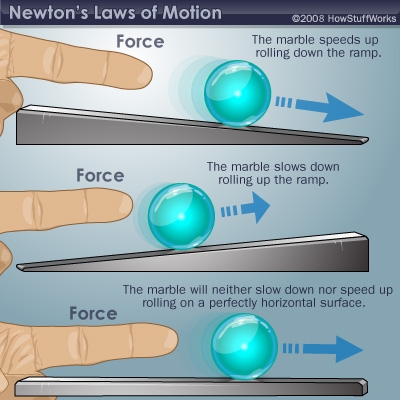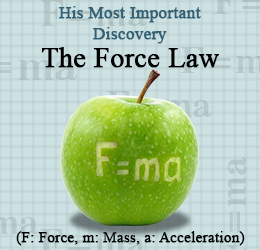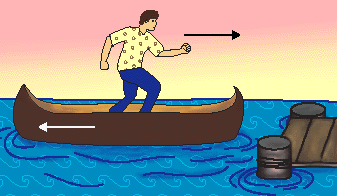Let us begin our explanation of how Newton changed our understanding of the Universe by enumerating his Three Laws of Motion.
Newton’s First Law of Motion:
| I. Every object in a state of uniform motion tends to remain in that state of motion unless an external force is applied to it. |

Newton’s First Law of Motion: Law of Inertia
This we recognize as essentially Galileo’s concept of inertia, and this is often termed simply the “Law of Inertia”.
Let’s restate Newton’s first law in everyday terms:
- An object at rest will stay at rest, forever, as long as nothing pushes or pulls on it. An object in motion will stay in motion, traveling in a straight line, forever, until something pushes or pulls on it.
The “forever” part is difficult to swallow sometimes. But imagine that you have three ramps set up as shown below. Also imagine that the ramps are infinitely long and infinitely smooth. You let a marble roll down the first ramp, which is set at a slight incline. The marble speeds up on its way down the ramp. Now, you give a gentle push to the marble going uphill on the second ramp. It slows down as it goes up. Finally, you push a marble on a ramp that represents the middle state between the first two — in other words, a ramp that is perfectly horizontal. In this case, the marble will neither slow down nor speed up. In fact, it should keep rolling. Forever.
Interestingly, Newton wasn’t the first scientist to come up with the law of inertia. That honor goes to Galileo and to René Descartes. In fact, the marble-and-ramp thought experiment described previously is credited to Galileo. Newton owed much to events and people who preceded him. Before we continue with his other two laws, let’s review some of the important history that informed them.
Newton’s Second Law of Motion:
| II. The relationship between an object’s mass m, its acceleration a, and the applied force F is F = ma. Acceleration and force are vectors (as indicated by their symbols being displayed in slant bold font); in this law the direction of the force vector is the same as the direction of the acceleration vector. |

Second Law of Motion: Force = Mass x Acceleration
This is the most powerful of Newton’s three Laws, because it allows quantitative calculations of dynamics: how do velocities change when forces are applied. Notice the fundamental difference between Newton’s 2nd Law and the dynamics of Aristotle: according to Newton, a force causes only a change in velocity (an acceleration); it does not maintain the velocity as Aristotle held.
This is sometimes summarized by saying that under Newton, F = ma, but under Aristotle F = mv, where v is the velocity. Thus, according to Aristotle there is only a velocity if there is a force, but according to Newton an object with a certain velocity maintains that velocity unless a force acts on it to cause an acceleration (that is, a change in the velocity). As we have noted earlier in conjunction with the discussion ofGalileo, Aristotle’s view seems to be more in accord with common sense, but that is because of a failure to appreciate the role played by frictional forces. Once account is taken of all forces acting in a given situation it is the dynamics of Galileo and Newton, not of Aristotle, that are found to be in accord with the observations.
Newton’s Third Law of Motion:
| III. For every action there is an equal and opposite reaction. |
 This law is exemplified by what happens if we step off a boat onto the bank of a lake: as we move in the direction of the shore, the boat tends to move in the opposite direction (leaving us facedown in the water, if we aren’t careful!).
This law is exemplified by what happens if we step off a boat onto the bank of a lake: as we move in the direction of the shore, the boat tends to move in the opposite direction (leaving us facedown in the water, if we aren’t careful!).
Newton’s third law is probably the most familiar. Everyone knows that every action has an equal and opposite reaction, right? Unfortunately, this statement lacks some necessary detail. This is a better way to say it:
- A force is exerted by one object on another object. In other words, every force involves the interaction of two objects. When one object exerts a force on a second object, the second object also exerts a force on the first object. The two forces are equal in strength and oriented in opposite directions.
